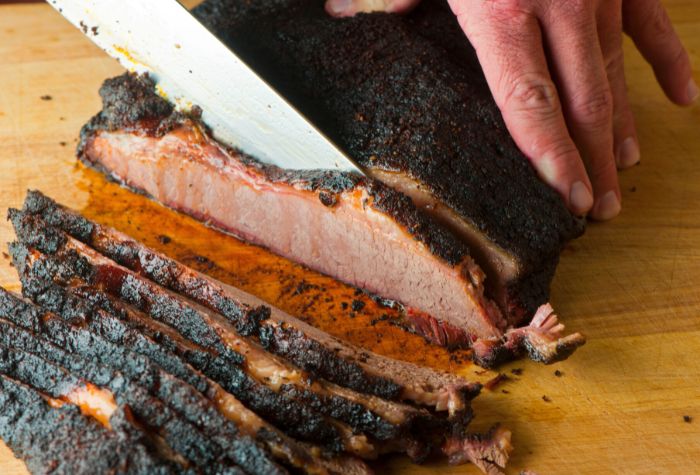Serve your smoked beef and grilled steak the right way by cutting meat against the grain. The why and how to slice beef muscle fibers for perfectly tender meat.

Cutting meat against the grain is something we are told to do in countless recipes for grilled steaks, smoked briskets, and more. But do you actually know what it means to cut against the grain or why it’s so important to cut against the grain? Do you know how to identify the grain on a cut of meat?
Don’t worry if you’re a bit unsure – it seems to be one thing that people are supposed to know is an essential step in preparing steak and other cuts of meat without anyone really explaining it.
We’ve put together a quick guide on all you need to know about grain when it comes to meat, the Grain Gospel if you will – we’ve covered what ‘the grain’ is, how to find it and why it’s so essential to slice meat against the grain. Here’s how to cut meat against the grain.
What is the Grain of Meat?

The grain of meat refers to the way the muscle fibers are organized and aligned in a cut of meat. These fibers, how they knit together, and the direction that they run give meat its texture and structure.
Tougher beef cuts have more pronounced grain, like brisket, flank steak, and skirt steak, whereas more tender cuts like beef tenderloin have less distinct grain because the muscle fibers are finer.
The grain can often be found by looking for the little white lines of fat and connective tissue that run across the meat. These sit as little pockets between the fibers and run with the meat’s grain, making it easy to find.

How to Find the Grain
The grain of the meat is easier to find in some cuts than others. In tougher cuts such as flank, skirt, and hanger steak, the grain is easy to identify. This is because they are cut from muscle groups that are worked hard and have larger fiber bundles producing a coarse grain. The grain in these cuts of meat can be likened to wood grain – it looks like long lines that run parallel to each other, as you’d see in a wooden plank or piece of timber.
Tender cuts such as rib and sirloin come from muscles that aren’t as well-worked, making the grain finer, smaller, and harder to see.
Meanwhile, if you are cutting brisket you will divide the point and flat parts as their grains are set in different directions to one another. See our guide on how to cut brisket to find out more.
If you are struggling to see the grain in any cut of meat, one trick you can try is to pull the meat gently from either end, as if you were stretching it. This should allow you to see some of the fibers separate.

Why Slice Meat Against the Grain
We cut against the grain to help break down the tough muscle fibers, making the meat more tender and easier for us to chew. This is especially important in grilled and seared meat (like steak) because the hot-and-quick cooking process doesn’t allow enough time for the meat to render and become tender.
Slicing against the grain makes these muscle fibers shorter. Long fibers in meat will be tough as you’re having to work hard to separate the lengths of fibers from each other as you are chewing. If we make the fibers short by cutting against the grain when serving, they are far easier to chew.
What Happens if You Slice Parallel to the Grain?
If you slice meat parallel to the grain, meaning you cut along the length of the grain lines, you will make it harder to separate the muscle fibers when chewing.
Even the most tender and perfectly cut piece of meat can end up tasting chewy if it’s been cut incorrectly.

How to Cut Meat Against the Grain
- In raw meat, you can find the grain by looking for the white lines of fat and connective tissue that run along the cut of meat. If they aren’t easy to find then you can try pulling on either end of the meat to see which way has the most give. With certain cuts, usually tougher ones, you can sometimes pull the meat as if stretching it, and the grain of the meat will become more apparent.
- With cooked meat, the grain can sometimes be harder to see from the surface. If you are really struggling to find it, cut a small section of meat off of one end. You’ll be able to see the grain more clearly on the cut section: If the grain lines run up and down, then you’ve cut it correctly and can carry on. If the grain lines run side to side, turn your meat on your chopping board 90°, and then you’re all good to go.
- Once you’ve found the grain, place your meat on your chopping board so that the grain runs parallel to the long edge of your chopping board (you want the grain lines to run from left to right in relation to you, not up and down).
- Take your knife and cut the meat so that you are cutting across or against the grain. You want the knife to be perpendicular to the grain direction, not parallel.










